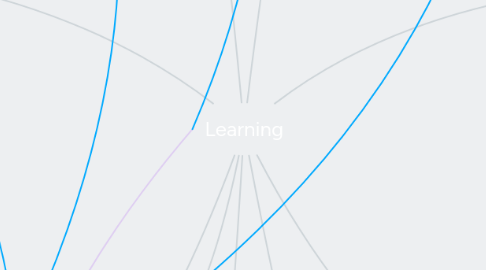
1. Teacher
1.1. Lecturing
1.1.1. one direction of knowledge from teacher to student
1.2. Facilitating
1.2.1. shaping of learning process together
1.3. Scaffolding
1.3.1. Allowing learners to achieve difficult task safely in a supported way by gradually increasing difficulty
1.3.1.1. Recruitment, reduction in degrees of freedom, direction maintenance, making critical features, frustration control, demonstration
1.4. Caring relationship with students
1.4.1. know students, be empathetic, understanding, create a caring environment
1.4.2. build rapport
1.5. Evaluate, give feedback
2. Memory
2.1. Types of Memory
2.1.1. Sensory Memory
2.1.1.1. Auditory memory: 2-3 seconds
2.1.1.2. Visual memory: fraction of a second
2.1.2. Working Memory
2.1.2.1. ability to hold information for a brief period and work with it
2.1.3. Long-term Memory
2.1.3.1. unlimited, long-term or permanent storage of information
2.2. Memory Theories
2.2.1. Cognitive Load Theory
2.2.1.1. Working memory is limited
2.2.1.2. Working memory overload
2.2.1.2.1. Habituation can occur
2.2.1.2.2. Signs of memory overload: incomplete recall, failing to follow instructions, place-keeping errors, task abandonment
2.2.1.2.3. Teacher must reduce content, give brain breaks
2.2.2. Dual Coding Theory
2.2.2.1. Humans learn through verbal and non-verbal information (or imagery)
2.2.2.2. modality or multimedia principle
2.2.2.2.1. use of words and graphics
2.2.2.3. redundancy principle
2.2.2.3.1. redundant materials impede learning
2.2.2.4. spatial contiguity or split-attention principle
2.2.2.4.1. integrate materials when possible
3. Metacognitive Theory
3.1. when learners plan, monitor, evaluate and make changes to their own learning behaviors. Metacognitive Strategies may be used to improve metacognition.
3.2. Metacognitive Knowledge
3.2.1. declarative knowledge: knowing what to do
3.2.2. procedural knowledge: knowing how to use the strategies
3.2.3. conditional knowledge: knowing the conditions, when and why
3.3. Metacognitive Regulation
3.3.1. Planning
3.3.1.1. learners plan for time, strategies, resources, chronology, what to study, what task, which strategies to use, how to start, what steps to take
3.3.2. Monitoring
3.3.2.1. awareness of monitoring the process of learning
3.3.3. Evaluation
3.3.3.1. making judgements about processes and outcomes of learning, whether the strategies are going well
3.4. Metacognitive Strategies
3.4.1. Be explicit
3.4.2. Say what you don't want
3.4.3. check understanding of task
3.4.3.1. questioning
3.4.4. early performance based assessments
3.4.4.1. problem solving activities, quizzes
3.4.5. opportunities for self-assesment
3.4.5.1. questioning, self-assessment
4. Motivation Theory
4.1. Expectancy Value Theory
4.1.1. expectations for success and subjective values lead to motivations
4.1.2. Value
4.1.2.1. Attainment value
4.1.2.1.1. personal importance of how one does well on the task
4.1.2.2. Intrinsic value
4.1.2.2.1. how one enjoys the subject or task
4.1.2.3. instrumental/utility value
4.1.2.3.1. how one can use the task for their current or future goals
4.1.2.4. cost value
4.1.2.4.1. the cons of doing a task
4.1.3. Expectancies
4.1.3.1. Outcome
4.1.3.1.1. belief that action will lead to desirable outcome
4.1.3.2. Efficacy
4.1.3.2.1. beliefs of how effectively one can perform the action for the outcome
4.2. Self-determination Theory
4.2.1. Humans are self-motivated, self-determined
4.2.2. Autonomy
4.2.2.1. Feeling of personal and self control
4.2.3. Belonging
4.2.3.1. Innate need for feelings of relatedness and attachment
4.2.4. Competence
4.2.4.1. Feeling of capability and success
4.3. Carol Dweck: Mindset and motivation
4.3.1. Having a growth mindset leads to more learning - praising children for effort instead of intelligence so they have a change in mindset of growing more
4.4. Teacher can motivate students via
4.4.1. Praise
4.4.2. Engaging their interests
4.4.3. Learning about their learners
5. Theory
6. Learning Theory
6.1. Behaviorism
6.1.1. Classical Conditioning (Pavlov, Watson)
6.1.1.1. All behavior is learned from the environment, behavior is observable
6.1.1.2. involuntary response to stimuli
6.1.2. Operant Conditioning (Thorndike, Skinner)
6.1.2.1. Law of Effect: Behavior occurs or does not occur depending on outcomes
6.1.2.2. Reinforcement & Punishment
6.1.2.2.1. Punishment weakens response
6.1.2.2.2. Reinforcement strengthens response
6.2. Constructivism
6.2.1. Cognitive Constructivism (Piaget)
6.2.1.1. Discovery based
6.2.1.2. Schema
6.2.1.2.1. mental representation that already exists
6.2.1.2.2. Adaptation
6.2.2. Social Constructivism (Vygotsyky)
6.2.2.1. Learning is social
6.2.2.2. Learning is shaped solely by social interactions
6.2.2.3. ZPD (Zone of Proximal Development)
6.2.2.3.1. children have prior knowledge and draw reference on their schema - not blank slates
6.2.2.3.2. distance between what a learner can do without support and what a learner can do with support from an expert
6.2.2.4. Scaffolding
6.2.2.4.1. establishing shared understanding of task
6.2.2.4.2. establishing prior knowledge of learner
6.2.2.4.3. identify goal and strategies to achieve goal, and assess whether goal is achieved
7. Skills
7.1. Feedback (7 criterias)
7.1.1. goal referenced
7.1.1.1. specific about goal
7.1.2. tangible and transparent
7.1.2.1. specific, clear feedback
7.1.3. Actionable
7.1.3.1. concrete, specific, and useful
7.1.4. User friendly
7.1.4.1. avoid overly technical, or nuanced language
7.1.5. Timely
7.1.5.1. feedback sooner than later
7.1.6. Ongoing
7.1.6.1. Opportunities to implement feedback
7.1.6.1.1. Formative assessment (i.e. weekly quizzes, in-class discussions): feedback to improve learning
7.1.6.1.2. Summative assessment (i.e. Exams, projects, essays) : evaluates students against a benchmark
7.1.7. Consistent
7.1.7.1. Clear criteria and rubric
7.2. Practice
7.2.1. thinking about the objectives, outcomes
7.2.2. structuring practice for acclimation and assimilation
7.2.3. Flow: balance between ability and change- Enjoyable practice that time flows
7.2.3.1. Flow Theory
7.2.3.1.1. Getting into the zone, controlling consciousness
7.2.3.1.2. set of clear goal, process
7.2.3.1.3. positive environment
7.2.4. Spacing out the practice: deciding how many times and how often to practice
8. Learner
8.1. novice or expert
8.1.1. expert learners have more knowledge, tackle problems faster
8.1.2. novice learners have less background knowledge, tackle problems slower
8.2. Gaps or existing factors
8.2.1. knowledge
8.2.2. skills
8.2.3. motivation
8.2.4. habits
8.2.5. environment
8.2.6. communication
8.2.7. Schema (Cognitive Constructivism)
8.3. Learning styles
8.3.1. Audio, visual or hands-on learner
9. Settings for learning (can be one or more)
9.1. Social
9.1.1. occurs in any setting
9.1.2. occurs via interaction with others
9.2. Informal
9.2.1. occurs anywhere, self-directed, no formal goals
9.2.2. occurs in any setting
9.3. Formal
9.3.1. delivered in a systematic way
9.3.2. planned and guided by an instructor
9.3.2.1. forward-design
9.3.2.1.1. plan content/syllabus, how to teach content/methodology, assessment/goals
9.3.2.2. backwards design
9.3.2.2.1. identify desired results, determine acceptable evidence, plan learning experiences and instruction
9.3.3. face-to-face or online
